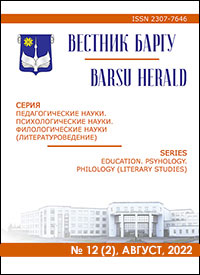INTERACTION ORGANIZATION WITH STUDENTS OF SPECIALIZEDPEDAGOGICAL CLASSES AS A MEANS OF COMMUNICATION COMPETENCESDEVELOPMENT OF STUDENTS OF PEDAGOGICAL SPECIALTIES
Keywords:
specialized pedagogical class; group of pedagogical orientation; interaction; communicative competencies of the future teacherAbstract
The article presents the characteristics of the content and forms of work with students of specialized classes and groups of pedagogical orientation of the III stage of general secondary education through the organization of their interaction with students of pedagogical specialties of the educational institution “Baranovichi State University”. The proposed forms are implemented in accordance with the principles of the development of pedagogical education, presented in the Concept of the Development of Pedagogical Education in the Republic of Belarus for 2021—2025. The key communicative competencies of the future teacher are reflected, the development of which is facilitated by the designated
forms of interaction: the ability to overcome communication barriers, communication flexibility, the ability to model upcoming communication, the value judgments formulation, the ability to argue oneʼs position, the ability to create a positive attitude to the communication process and others. A comparative analysis of studentsʼ self-assessment of a number of communicative competencies at the stage of the beginning of training in a pedagogical orientation group and at its completion was carried out.
Table 1. Ref.: 9 titles.
Downloads
Published
Issue
Section
License
Copyright (c) 2023 Вестник БарГУ Серия "Педагогические науки. Психологические науки. Филологические науки"
Это произведение доступно по лицензии Creative Commons «Attribution-NonCommercial» («Атрибуция — Некоммерческое использование») 4.0 Всемирная.
Авторы сохраняют за собой право заключать определенные договорные соглашения, касающиеся неисключительного распространения опубликованной версии работы (например, размещать ее в институциональном репозитории, публикация в книге) со ссылкой на ее первоначальную публикацию в этом журнале.





